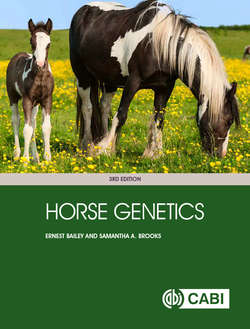Читать книгу Horse Genetics - Ernest Bailey - Страница 37
На сайте Литреса книга снята с продажи.
Rare fertility in mules and hinnies
ОглавлениеHistorically, the hybrid cross between the domestic horse and donkey species was agriculturally highly important. The offspring of a female horse and a male donkey is called a mule; the reciprocal cross between a female donkey and a male horse produces a hybrid called a hinny. Both hybrids have 63 chromosomes; 32 from the horse parent and 31 from the donkey parent. The ovaries of most female horse/donkey hybrids are usually non-functional (atrophic) and males do not produce sperm (they are azoospermic). The occurrence of fertile mules is very rare because of the failure to produce viable gametes. Some rare exceptions have been documented. Ryder et al. (1985) used karyotyping and blood typing to confirm the parentage of a jack (male) mule foal by a Welsh pony stallion out of a molly (female) mule. Karyotyping studies of fertile female mules and hinnies in China have also been reported (Rong et al., 1988). The explanation of documented fertile mules has been suggested to be a consequence of hemiclonal transmission, a phenomenon in which the mother passes along the chromosomes from the mother but not the father. In other words, these viable offspring are not true species hybrids. In these rare and well-documented cases, the offspring inherited only the domestic horse chromosomes and were genetically horses insofar as their chromosomes were concerned. Hemiclonal transmission has been observed in some amphibians but, other than these exceptional cases, is unknown in mammals. Because it is so rare, the mechanism for hemiclonal transmission in equids is a mystery.
